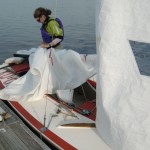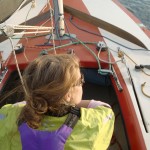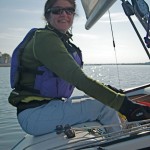This has to be one of the best descriptions of the dynamics at play in scow sailing and why many people find the boat to behave so, well, kindly at high speeds and fresh winds. The Melges 17 scow referenced here has many of the high tech innovations found in modern skiffs, but all scows enjoy the hull characteristics. Continue reading Scow stability explained
Category Archives: Stew’s Log
Stew posts his log entries in this category
First Splash-2011
Our friends Ed and Georgette met us at the Washington Sailing Marina bright and early to learn the ropes on the M16 and try their hand at tacking and gybing.
Even at 9am when we wheeled the boat to the lift, it was feeling balmy with temps on their way to a high of 58F. March 5 is still winter, but you would never know it. A soft 4-8 knot southerly rippled the water with promise. Continue reading First Splash-2011
New York Sate E Scow Champs
The 28-foot E scow is big cousin to the I-20, with half again as much sail and hull. At 1000 lbs., E scows might take longer to accelerate, but their top speed upwind is magnificent. Some say the I-20 is just as quick downwind with the chute filled, but I would not be looking for this drag race after what I saw during a weekend flying the aspin on an E scow known as “E-ruption” during the New York State championships at Lake Chautauqua, New York. Continue reading New York Sate E Scow Champs
Sailing with Friends: 2010
Final Sailing Weekend: 2010
We knew the season was drawing to a close, so we were grateful the weekend before Thanksgiving when temps crept into the 50s and the sun came out to warm our shoulders. Winds were barely tickling the tree tops on Saturday, which was a perfect opportunity to splash the M-16. This great little boat had been sitting in the back yard since July 2009 when we took possession of an I-20 and devoted our sailing time to learning the ropes on that boat. So, this day sail felt like a reunion of sorts with our old friend, the M-16.

As part of the “celebration,” we had just acquired some new old sails from Sail La Vie in White Bear Lake, MN., so we were eager to see how the wind would like them. The main is a Bowers, still stiff and crinkly. The jib: a Melges with lots of telltales. In light winds that day, they filled with a nice shape, not too much pocket; the wind seemed to stick to them and the boat fairly jumped to a good speed on the 3-4 mph breeze.
These are really nice sails. We tacked and gybed around the estuary just in front of the docks on Daingerfield Island. I forgot how much I like this club racer.

I made notes on some improvements for the coming year: cleats for adjustable hiking straps, lighter jib sheets, better jib downhaul. It would be nice to run the boom vang back to the helm, but that can wait. The boards are a bit sticky in the bilge slots, so this winter we will remove them and check to make sure they are straight. That splash rail could use some varnish!
After we hoisted the boat, we rolled the sails (nice!) and gave the hull a good cleaning. With a little tweaking, this rig will be ready for races in the spring.

On Sunday, we dropped the I-20 known as Mr. Whistlebritches into the water and tacked through the channel to the open river. Variable winds kept us on the Potomac for 6 hours, but with warming sun, we did not mind. We took turns eating lunch from a thermos of soup. That, apples, and taking turns at the helm, seemed to evaporate the hours. The low light at this time of year is really lovely on the water.
